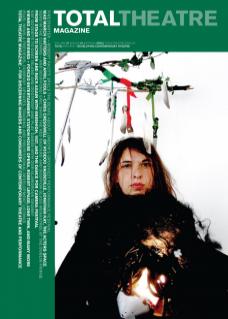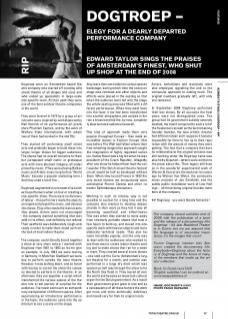Dogtroep were an Amsterdam based theatre company who started off creating wild street theatre of all shapes and sizes and who ended up specialists in large-scale site-specific work. At their peak they were one of the best outdoor theatre companies in the world.
They were formed in 1975 by a group of artists who were inspired by workshops led by Neil Hornick of UK performance-art pranksters Phantom Captain, and by the work of Welfare State International, with whom two of them had worked in the mid 70s.
They started off performing small street acts and gradually began to build these into larger, longer shows for bigger audiences. The shows had no overall narrative to them but juxtaposed small comic or grotesque acts with more abstract imagery, all underpinned by music. (They were playing Balkan music and Arabic music long before ‘World Music’ became a popular marketing term.) And they used a lot of fire...
Dogtroep augmented a core team of six with extra performers when on tour or creating a site-specific show. There were no divisions of labour – the performers made the objects, arranged and played the music, and devised the shows. They often made the instruments they played. Actors were not encouraged – the company wanted something that was wild in its effect, and definitely not refined. Their aesthetic was deliberately rough-and-ready in order to make them stand out from the look of most indoor theatre.
The company could literally knock together a show at very short notice. I worked with Dogtroep from 1981 to 1983 so let me give an example. In July 1983 we were touring in Germany. In Munchen Gladbach we were due to perform outside the town theatre. However it was lashing down, and so faced with having to cancel the show the company elected to perform in the theatre. In an afternoon they put together a script which transformed the various spaces of the theatre into a real journey of surprise for the audience. I’ve never seen such an extraordinary manipulation of different spaces. After experiencing an introductory performance in the foyer, the audience came into the auditorium to see a scene on the stage; they were then were taken to various spaces backstage, during which time the scene on stage was removed and other objects and effects were placed in the seating so that when the audience were led onto the stage the whole seating area was filled with a different performance. When they went back into the foyer it too had been transformed into another atmosphere and outside in the rain a brass band bid the, by now, completely disorientated audience farewell.
This kind of approach made them very popular throughout Europe – they made an incredible impact in Eastern Europe (this was before The Wall had fallen) where their free-wheeling imaginative approach caught the imagination of highly regulated societies. Vaclav Havel was a big fan when he was president of the Czech Republic. Allegedly, after one show he helped them load the van. I wonder if the Dutch street theatre festival circuit would be half as developed without them. When they toured France in 1982 the only street theatre we encountered were sentimental Pierrot Clowns and other romantic Saltimbanque characters.
Working in such an intense way is not possible to sustain for a long time and the company also wanted to develop deeper strands in their work as they felt it was all becoming superficial and effect-heavy. This was when they started to move away from relatively portable shows that took a few hours to build up, and moved into sitespecific work with heavier objects and more elaborate technical needs. They also became incredibly popular, and the only way to deal with the audiences who wanted to see them was to create indoor theatre seating and to make shows that ran for a week or more. They created several iconic shows – one sold out the Carre (Amsterdam’s largest theatre) for a month, and another was performed in a large dry dock which was opened up half way through the show to let the North Sea flood in. They toured all over the world and became an important cultural export for the Dutch government. As a result their government grant grew in size and as a consequence of all these factors the work got more and more technically ambitious and moved very far from its original roots.
Actors, technicians and musicians were also employed, signalling the end to the vernacular approach to making work. The original members gradually left, until only one remained.
In September 2008 Dogtroep performed their last shows. By all accounts the final years were not distinguished ones. The group had its government subsidy severely slashed, the board conspired to sack a lot of the freelancers as well as the last remaining founder member, the new artistic director had different ideas and I suppose it became impossible for them to live up to their reputation with the amount of money they were getting. The fact that a company that bore no relationship to the original versions was still working under the Dogtroep name was also hotly disputed – letters were written to the press about this. Their legacy still lives on in the wonderful experimental work of Warner & Consorten (formed over ten years ago by Warner Van Wely); the community music projects of Jos Zandvliet; and the subtle public installation work of Lino Hellings – all three being original founder members of the company.
RIP Dogtroep - you were bloody fantastic!
The company closed activities end of 2008 with the publication of a book and the release of a documentary flm. Dogtroep - 33 Jaar Beeldend Theater is in Dutch, but we are assured that ‘the language is of secondary importance, it’s the images that count’.
Former Dogtroep member Udo Akemann created the documentary flm Everybody=Dogtroep about the history of Dogtroep and the future of many of the members that made up the artists’ collective.
Book (in Dutch) and DVD (English subtitles) can be ordered at: www.lavapublishers.nl

